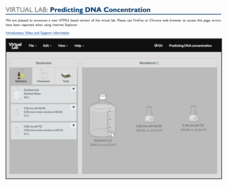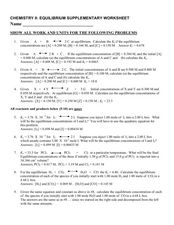Chemistry Collective
Virtual Lab: Unknown Concentration of DNA Solution Problem
Highlight DNA solution with fluorescent dyes! Scholars use dye to determine the concentration of a DNA solution. As the dyes bind with the DNA solution, learners make conclusions about the limiting reactants.
Chemistry Collective
Virtual Lab: Predicting DNA Concentration
Play a little game of concentration! A virtual lab investigation allows learners to predict the products and reactants of a DNA reaction. They make their calculations and then test their predictions in the lab workbench.
Curated OER
Chemical Reaction Rates
Students observe demonstrations to show factors that affect rates of chemical reactions. In this rates of chemical reactions instructional activity, students investigate how catalysts, reactant concentrations, temperature and surface...
Curated OER
Rates of Chemical Reactions-The Iodine Clock Reaction
High schoolers investigate the reaction rate of iodine and soluble starch. In this rates of chemical reactions lesson plan, students study the effects of varying concentrations of reactants and varying temperatures of reactants on the...
Curated OER
Concentration and Reaction Rates
Students investigate how varying the concentrations, volumes, and other factors affects reaction rates. Students design and conduct investigations to obtain data used to create graphs of an uncatalyzed reaction vs. a catalyzed reaction....
Curated OER
Approaching Equilibrium
Contrary to a common popular belief, equilibrium does not mean a reaction has stopped. An interesting presentation covers reactant concentrations and product concentrations. It describes the equilibrium as when the forward rate equals...
Curated OER
Dilution and Concentration of Solutions
Future chemists practice laboratory techniques by creating a monochloramine solution. The objectives are to use of dilution, 9concentration, and measurement skills and to prepare a solution that will be used in a water treatment...
Curated OER
Limiting Reactant
In this chemistry worksheets, students calculate the amount of reactants and products are produced by the given equations. Students also calculate the number of moles as well as the mass of the given compounds.
Curated OER
Equilibrium Practice
In this chemical reactions worksheet, students determine solubility product expressions, equilibrium constants, and equilibrium concentrations. This worksheet has 15 multiple choice questions and 3 problems to solve.
Virginia Department of Education
The Rate of a Chemical Reaction
If your pupils think a catalyst is a list of their cats, then this might be the lesson for you! Young chemists study the effect of temperature, catalysts, concentration, and particle size on reaction rates during four different...
Curated OER
The Speed of Chemistry
In this rates of chemical reactions worksheet, high schoolers read about the various factors that influence the rate of chemical reactions such as surface area, concentration, temperature and catalysts. Students answer eight questions...
Curated OER
Chemistry Lab: Chemical Equilibrium
Students investigate the effects of adding or removing a reactant or a product on chemical equilibrium. In this equilibrium lesson plan, students add or remove ions to solutions to determine the effects on equilibrium. They make...
Curated OER
WS 9.2 Equilibrium
In this equilibrium worksheet, students fill in twenty one blanks with terms related to reactions and equilibrium. They then solve four problems given chemical reactions and determine equilibrium, moles present at equilibrium and...
Curated OER
WS 9.3 Le Chatelier's Principle
In this Le Chatelier's Principle worksheet, learners are given three chemical reactions along with various disturbances on the systems. They must indicate the effects of each disturbance on the concentrations of products and reactants in...
Curated OER
The "Clock Reaction" Kinetics Lab
Students investigate the effects of temperature and concentration on the rate of reactions. In this "clock reaction" kinetics lesson plan, students change the concentration of one reactant and keep the second constant. An indicator is...
Curated OER
Are All Equilibria Created Equal
In this equilibrium activity, learners read about the factors that effect equilibrium in solutions such as the pressure of the solution, the temperature and the concentration of the solution. They answer three multi-part questions about...
Curated OER
Water Vapor Equilibrium
In this chemistry worksheet, students complete 12 short answer questions and problems on water vapor equilibrium. They calculate equilibrium concentrations of reactants and products.
Curated OER
Equilibrium Supplementary Worksheet
In this equilibrium worksheet, students calculate the equilibrium constant and concentration to answer 13 problems. They predict the shift of the reaction when certain species are added.
Science Geek
Reaction Kinetics
Show your classes the science behind rates of reactions with a presentation that explains factors that affect the rate, activation energies, exothermic and endothermic processes, and the proportionality of the product and reactant rates.
Cornell University
Predicting Chemical Reactions
Prove the Law of Conservation of Mass through a lab investigation. A well-designed lesson asks groups to combine materials and monitor indicators for chemical reactions. Measuring the mass of the reactants and products allows individuals...
LABScI
Freezing Point Depression: Why Don’t Oceans Freeze?
Can you go ice fishing in the ocean? Learners examine the freezing point of different saltwater solutions. Each solution has a different concentration of salt. By comparing the freezing points graphically, they make conclusions about...
Royal Society of Chemistry
A Microscale Acid-Base Titration
Watch as acids and bases put smiles on their faces. Young chemists learn the concept of acid-base titration firsthand in a microscale experiment. Working groups collaborate, titrate, then use their data to determine the concentration of...
Curated OER
2000 U.S. National Chemistry Olympiad National Exam - Part I
The National Chemistry Olympiad exams are comprehensive tests covering an entire year of chemistry concepts. You can use them as practice for competing in the challenge, or simply as a review, or as an actual final exam for your general...
Chemistry Collective
Virtual Lab: Camping Problem II
What happens to the enthalpy of a reaction as the concentration of reactants varies? Learners explore this question with a virtual lab activity. They consider five different solutions of the same reactants and monitor the temperature...

























